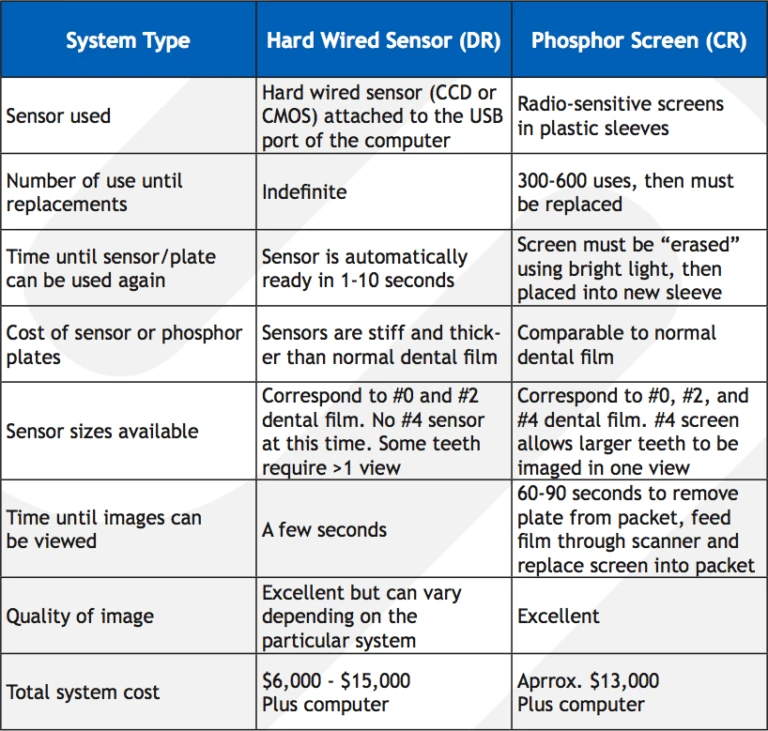Two main types of digital systems are available today:
DR systems include a “sensor” and software, and are used with an existing dental X-ray machine and computer. The sensor is connected via USB cable to a computer, and is placed in the patient’s mouth and positioned like ordinary dental film. (show image of the X-Ray generator and a film in a dog’s mouth like in positioning guide) The largest sensor size currently available approximates the size of #2 dental film. Images are viewed in seconds, and may be digitally manipulated to heighten detail and minimize re-takes. The sensors are the most expensive part of the system, and although they are quite durable, care must be taken to prevent damage.
CR systems involve the use of “phosphor screens”, which look similar to ordinary dental film. After exposure, the screens are fed into a scanner, which gives you an image in around one minute. The phosphor screens are exposed to bright light to erase the prior image, and can be re-used hundreds of times. This type of system is more expensive, but does have the advantage of being able to produce larger #4 films.
The chart below compares various features of DR and CR systems. DR systems are currently more popular due to the speed with which you can obtain images.



Thank you for your sharing. I am worried that I lack creative ideas. It is your article that makes me full of hope. Thank you. But, I have a question, can you help me?
Can you be more specific about the content of your article? After reading it, I still have some doubts. Hope you can help me. https://accounts.binance.com/ro/register-person?ref=V3MG69RO
Your point of view caught my eye and was very interesting. Thanks. I have a question for you. https://accounts.binance.com/da-DK/register?ref=V2H9AFPY
Your point of view caught my eye and was very interesting. Thanks. I have a question for you. https://www.binance.com/en-IN/register?ref=UM6SMJM3
Thank you for your sharing. I am worried that I lack creative ideas. It is your article that makes me full of hope. Thank you. But, I have a question, can you help me?
Your article helped me a lot, is there any more related content? Thanks!
Thanks for sharing. I read many of your blog posts, cool, your blog is very good. https://accounts.binance.com/ru/register?ref=V3MG69RO
Your point of view caught my eye and was very interesting. Thanks. I have a question for you.
Understanding the difference between Dental CR and Dental DR is crucial for effective dental imaging. Much like the descendants 3 hades costume which stands out with its unique design, each imaging method has its distinct features. CR uses imaging plates for capturing images, while DR provides instant results with direct digital capture. Both play important roles in modern dentistry, enhancing diagnostic accuracy and patient care.
Your point of view caught my eye and was very interesting. Thanks. I have a question for you.
Your point of view caught my eye and was very interesting. Thanks. I have a question for you.
Thank you for your sharing. I am worried that I lack creative ideas. It is your article that makes me full of hope. Thank you. But, I have a question, can you help me?
Your point of view caught my eye and was very interesting. Thanks. I have a question for you.
Thank you for your sharing. I am worried that I lack creative ideas. It is your article that makes me full of hope. Thank you. But, I have a question, can you help me?
I don’t think the title of your article matches the content lol. Just kidding, mainly because I had some doubts after reading the article.
Your point of view caught my eye and was very interesting. Thanks. I have a question for you.
Can you be more specific about the content of your article? After reading it, I still have some doubts. Hope you can help me.
Thank you for your sharing. I am worried that I lack creative ideas. It is your article that makes me full of hope. Thank you. But, I have a question, can you help me?
Can you be more specific about the content of your article? After reading it, I still have some doubts. Hope you can help me. https://accounts.binance.com/ru-UA/register?ref=OMM3XK51
Can you be more specific about the content of your article? After reading it, I still have some doubts. Hope you can help me.
I don’t think the title of your article matches the content lol. Just kidding, mainly because I had some doubts after reading the article.
Thank you for your sharing. I am worried that I lack creative ideas. It is your article that makes me full of hope. Thank you. But, I have a question, can you help me?
Thank you for your sharing. I am worried that I lack creative ideas. It is your article that makes me full of hope. Thank you. But, I have a question, can you help me?
I regard something genuinely special in this web site.
Your point of view caught my eye and was very interesting. Thanks. I have a question for you.
Can you be more specific about the content of your article? After reading it, I still have some doubts. Hope you can help me.
HgWZ
HgWZ’OXymIYmVBBJd
HgWZ’) ORDER BY 1– qqir
HgWZ’) ORDER BY 4– XjbQ
HgWZ’) ORDER BY 3– DWyP
HgWZ
Thanks for sharing. I read many of your blog posts, cool, your blog is very good.
Thanks for sharing. I read many of your blog posts, cool, your blog is very good.
Thanks for sharing. I read many of your blog posts, cool, your blog is very good.
2021
Your article helped me a lot, is there any more related content? Thanks!
Your point of view caught my eye and was very interesting. Thanks. I have a question for you.
I don’t think the title of your article matches the content lol. Just kidding, mainly because I had some doubts after reading the article.
Thanks for sharing. I read many of your blog posts, cool, your blog is very good.
It’s interesting to learn about DR systems and their role in improving efficiency and accuracy, particularly in industries like healthcare. These systems play a crucial part in streamlining processes and enhancing workflow. Similarly, just as DR systems provide a smooth and efficient experience, elux juice offers a refreshing and energizing boost that helps keep you at your best. Whether you’re working with advanced systems or simply going about your day, staying refreshed and focused is key, and elux juice is a great way to stay energized.
Soundvet.com could expand its offerings by featuring a holiday section with christmas family outfits for pictures This would add a fun, festive touch to the website, catering to families looking for coordinated attire to celebrate the season. It’s a great way to combine holiday cheer with a memorable shopping experience.
Can you be more specific about the content of your article? After reading it, I still have some doubts. Hope you can help me.
I know this site provides quality depending articles or reviews and other material, is thee anny
other website which provides these stuff in quality? https://www.waste-Ndc.pro/community/profile/tressa79906983/
Your article helped me a lot, is there any more related content? Thanks!
Can you be more specific about the content of your article? After reading it, I still have some doubts. Hope you can help me.
Thanks for sharing. I read many of your blog posts, cool, your blog is very good.
I don’t think the title of your article matches the content lol. Just kidding, mainly because I had some doubts after reading the article.
Thanks for sharing. I read many of your blog posts, cool, your blog is very good.
Can you be more specific about the content of your article? After reading it, I still have some doubts. Hope you can help me.
Can you be more specific about the content of your article? After reading it, I still have some doubts. Hope you can help me.
Can you be more specific about the content of your article? After reading it, I still have some doubts. Hope you can help me.
Your point of view caught my eye and was very interesting. Thanks. I have a question for you. https://www.binance.com/join?ref=P9L9FQKY
I don’t think the title of your article matches the content lol. Just kidding, mainly because I had some doubts after reading the article. https://www.binance.com/vi/register?ref=WTOZ531Y
Thank you for your sharing. I am worried that I lack creative ideas. It is your article that makes me full of hope. Thank you. But, I have a question, can you help me?
Your article helped me a lot, is there any more related content? Thanks!
Thank you for your sharing. I am worried that I lack creative ideas. It is your article that makes me full of hope. Thank you. But, I have a question, can you help me?